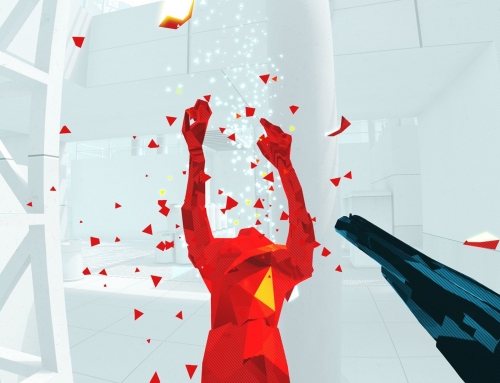A stunning game full of potential, if it can get there.
No Man’s Sky is an interesting game, to say the least. Visually, it brings about heavy reminders of Destiny, right down to the curser-like menu system. Gameplay wise, it’s more like Minecraft, but with the building elements restricted to only creating new items. In terms of story, it’s a strange, sparse science-fiction novel, touching on themes of loneliness, alien cultures, and strange hallucinations. These elements combine into an experience that feels immersive and gigantic, but ultimately empty and somewhat unfinished.

Upon starting the game, players are dropped immediately into the spacesuit of the main protagonist, a nameless, faceless being who has just crash landed on an alien world. Either stricken by amnesia or willfully ignorant of his new surroundings, the protagonist is visited by a strange alien sphere, urging him to follow it’s guidance. With very little in the way of tutorials or explanation, survival becomes the top priority.
This is a good time to mention that the worlds, creatures, and events of No Man’s Sky are procedurally generated, that is, they are created by a complex series of equations without human guidance. This can be both a wonderful journey into the unknown, or a frustrating experience with random numbers. Though there are a decent number of failsafe’s in place to prevent an absolutely unplayable game, results vary wildly with every planet. For instance, I found myself initially stranded on a planet with sparse resources and extreme daytime and night temperatures that kept me constantly attempting to restock my dwindling life support. A friend had his game drop him in an ideal, lush forest world, rich with resources, alien outposts, and beautiful sunsets. Neither of these experiences were overtly bad, and both speak to the unique nature of the game, but gamers should be aware that difficulty can spike wildly straight out of the opening cinematic.

For the most part, the game follows a simple pattern: collect resources from alien worlds, trade them to strange creatures for money, and upgrade your equipment, all while cataloging lifeforms you stumble across. There is something of a main storyline, which consists of a journey to the center of the universe, but it can be fairly safely ignored. However, a difficult to grasp navigation system means that, should a player get too far off course, it may be nigh-impossible for them to navigate back to the last story hook they dropped. For many explorers, this is just fine, and the thrill of the open cosmos will be enough, but to players wanting a narrative it can be a letdown. There are no action packed cut scenes or clever twists here, just an introspective trek across the stars.

The vast expanse of space is huge and varied, though not nearly as lonely as the trailers and promotional materials would have you believe. Massive alien freighters circle distant moons, pirate fleets strike from the shadows, and there are fragments of an ancient civilization everywhere. At times, the exploration takes on a very sci-fi feel, with dark relics that produce hallucinations, ancient monoliths buried underwater, and trading posts where spaceships constantly touch and go. It feels like there are hundreds of story ideas buried in this world, but like most of the other parts of the game, No Man’s Sky expects you to build them yourself. When action hits, it’s quick and jarring, whether it’s from a raider attack, angry carnivore, or surprisingly aggressive robots.
No Man’s Sky, above all else, exceeds in building an experience. With swelling synth textures and beautiful lighting, everything you encounter feels vibrant, alien, and mysterious. Aesthetically, the game is exceptional, producing screenshot-worthy fodder almost constantly. Unfortunately, the gameplay itself begins to suffer, hindering the overall power of a journey through space. A plodding land-movement speed, initially confusing control system, and lack of in-game help could make this less approachable to those unwilling to spend time learning it’s quirks. There are a few frustrating design choices when it comes to navigation, as returning to previously explored worlds can be arduous at best. The survival mechanics, which require the player to hunt down specific elements to refill environment and life support systems, can be a rude interruption to exploration, even when upgraded. Often times, I wanted to simply walk and enjoy the view, but my rapidly dwindling oxygen supply had me more focused on hunting plants every five minutes. It’s also easy to see how some players will find themselves bored: this game has a strong open-world, Minecraft feel, but without the extensive building. Hopefully, upcoming patches (confirmed to include base construction, among other improvements) will add in more to strengthen the later game adventure.

Should you buy No Man’s Sky now? This is a tricky question to answer, because while it contains a good deal of finished functions, it still very much feels like a work in progress. Flying around the universe and exploring random areas may be a perfect fit for some people, but anyone wanting constant action, a strong narrative, or a wide variety of activities will likely become bored after the initial awe has expired. For some, though, the allure of the open frontier is enough to fuel up the life support and take that first step again and again.
Zack Bolien
Latest posts by Zack Bolien (see all)
- Bloodstained: Ritual of the Night - June 25, 2019
- What is Panic’s Playdate? - May 24, 2019
- Battletome Review: Blades of Khorne - April 11, 2019






Leave A Comment